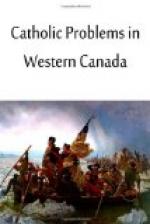CHAPTER V.
PLOUGHING THE SANDS
The Church-Union Movement: its Causes and Various Manifestations. The Protestant and Catholic View-Point.
Church-union is to-day the outstanding feature of the Protestant world. The possibilities and promises, the necessity and advantages of this movement are widely discussed in the press and magazine, in the pulpit and on the platform, in Church conferences and synods. Denominational barriers are being swept away; creed lines lowered; inevitably great changes are impending. This universal unrest is assuredly symptomatic of a chaotic Christendom outside of the true Church. The peace and self-confidence of the Catholic Church pursuing the even tenor of Her life is indeed in striking contrast.
No serious-minded Christian can be disinterested in this supreme effort of the various Christian denominations for unity. We are not allowed to doubt the good intentions that animate and direct the promoters of this inter-church movement. For, as Lord Morley said, “in the heat of the battle it often happens that men manifest towards the heretic feeling which should be exclusively reserved for the heresy.” Yet we believe that the explanation of our attitude, so much misunderstood and misinterpreted, cannot but help to hasten the day of the true and everlasting union, when in accord with the great desire of the Master, there will be but “One Fold and One Pastor.” Gladstone said: “Any man who advances one step the cause of Christian unity in his life may well lie down to die content that he had a life well lived.”
We said advisedly “our” attitude, for it is a vastly interesting point to note with Hilaire Belloc: “The Catholic understands his opponent, whereas that opponent does not understand him. A similar contrast existed once before in the History of Western mankind, to wit, in the latter days of the Roman Empire. The Catholic understood the Pagan; the Pagan did not understand the Catholic.”
Church-union was always more or less an ideal in the various non-Catholic denominations. Periodically efforts were made to realize this ideal; but they always failed in the presence of the bitter antagonism that existed between the leading factions. The Church-union movement manifested itself, timidly at first, in the interchange of pulpits, the united services and inter-communion of several denominations. This exchange in the ministerial field now prevails among the Nonconformists and has also affected to a large extent the Anglican communion. But the multiplied divisions and multiplying sub-divisions among the conflicting creeds, a wasteful overlapping and disastrous competition in the mission field, the enlightening experience of the great war, have forced an issue upon the Churches.




